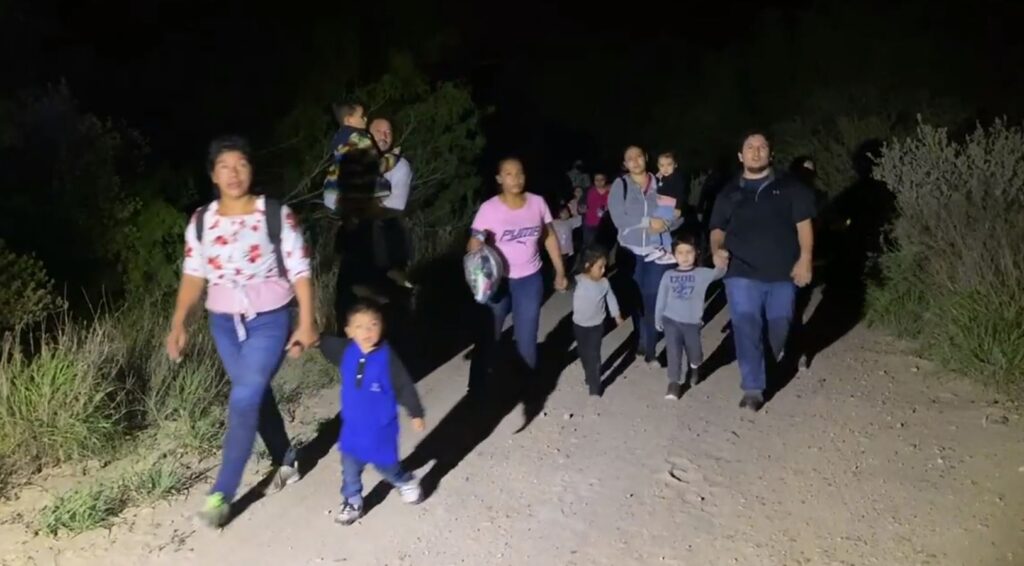
In all my years of working on the border, I had never witnessed anything like what I would see at just one of hundreds of openly established raft crossing points along the south Texas border, a reflective microcosm of a mass illegal immigration involving mainly families and children. All through that night and deep into the morning on the Texas riverbank, I watched what reminded me of a D-Day-like landing of Mexican cartel smugglers paddling blow-up rafts — sometimes two or three abreast in unending succession — brimming with men, women and children — under the indifferent watch of American authorities ordered by the Biden administration to stand down.
By Todd Bensman, as published May 26, 2021 by the Center for Immigration Studies
ROMA, Texas – The first two early clues that America’s burgeoning mass-migration phenomenon has become something nationally historic appeared out of the oil-black night on a white dust road leading from a residential outskirt of this rough-hewn Texas border town.
A small group of journalist friends and I had just begun the mile hike down the road to the Rio Grande, guided by a pistol-packing Christian pastor from the area, when a Border Patrol agent pulled up a vehicle to block our progress. As he and our armed preacher argued over whether land owner permission extended to us all, two teen-aged immigrant girls suddenly appeared behind the idling Border Patrol vehicle and peeked around at us shyly, waiting.
More curious about them than the heated discussion, I walked over and engaged with my terrible Spanish. Each indicated they were 16, Honduran, and had journeyed without their parents to begin new lives in America.
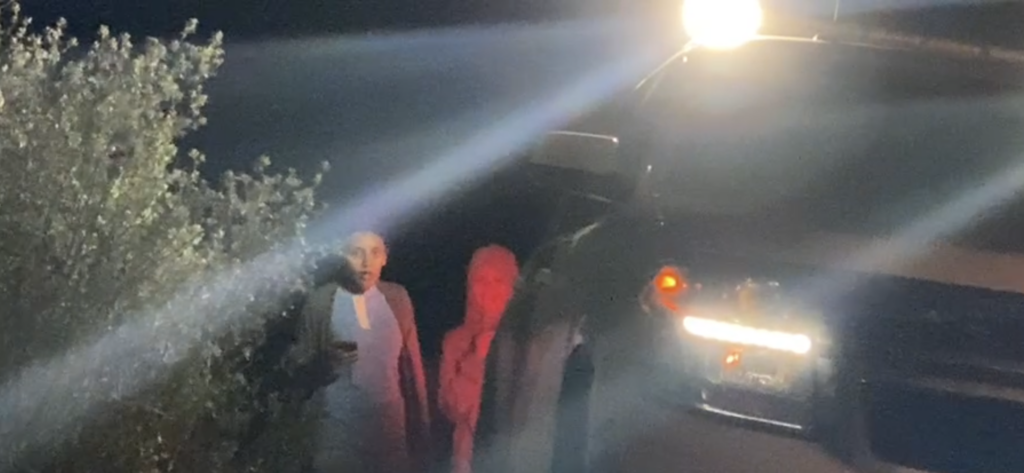
What the Border Patrol agent did next struck me – initially – as some sort of malpractice. He said a few words to them in Spanish, then drove away, leaving these underage, unaccompanied, unprotected girls among us strangers of unknown repute.
Continuing down to the river, we soon crossed paths with a group of 20 men, women and children coming up the same road with purpose, then another group. I realized then that the agent’s seeming abandonment of the 16-year-olds was nothing of the dereliction-of-duty sort.
The girls were merely fragments of a greater whole heading toward a makeshift Border Patrol processing station in the residential Roma neighborhood, which I hadn’t noticed, as they do now all night every night. The Border Patrol agent had been playing the now-worn new role of Walmart greeter, had merely directed the immigrants to the station where other agents would process them a step from final release into America.
In all my years of working on the border, I had never witnessed anything like what I would see at just one of hundreds of openly established raft crossing points along the south Texas border, a reflective microcosm of a mass illegal immigration involving mainly families and children.
All through that night and deep into the morning on the Texas riverbank, I watched what reminded me of a D-Day-like invasion of Mexican cartel smugglers paddling blow-up rafts – sometimes two or three abreast in unending succession – brimming with men, women and children— under the indifferent watch of American authorities ordered to stand down.
Mexican cartel raft pilots displayed little caution about the police all around as they stepped out of their rafts onto the Texas shoreline to unload passengers. They did so just feet away from National Guard soldiers, Border Patrol agents, and Texas Department of Public Safety officers who not very long ago would have pounced on them.
In a most unnatural truce between natural adversaries, all badged American authority figures now work under orders to do nothing that could possibly obstruct the nonstop deliveries of foreign families onto the Texas shore and everything to keep them moving inland to processing stations.
From seeing all of this up close and personally, two realizations struck me. One was that America’s current mass illegal immigration crisis has normalized into a streamlined, industrial fixture with conveyor-belt supporting infrastructure expanding on both sides of the border. It has transitioned from man-bites-dog newsworthy to 7-days-a-week, 365 days-a-year fait accompli part of the permanent landscape.
Cartel smugglers and the US government have openly and closely partnered in it, with no pretense otherwise; Often, the raft smugglers and American officers exchange salutations, quips, and helpful information about conditions in any given hour. The cops-arrest-crooks paradigm is sentimental memory here.
The national media no longer even considers this upside-down state to be news and has mostly left the audience after an initial intensity of interest. But while cameras and talk show hosts move on from hum drum, the human swell to the US side of the southern border has continued and escalated.
Through the end of April, more than 60,000 family unit members and unaccompanied teenagers had mounted the uninhibited conveyor belts into America. The immigrant families permitted to enter like this pushed overall January apprehensions from 70,000, to 100,000 in February, 172,000 in March, and 178,000 in April, the highest in more than two decades.
My other realization was that this particular mass immigration may well qualify as actually historic in the modern American experience, so rare and unusual that it probably merits cataloguing and recording for future generations. The most compelling qualification is that all past US mass-migration episodes have occurred in spite of frantic federal government efforts to stop, oppose, and attenuate the floods by any means necessary. But now an American government purposefully allows, enables, facilitates, and manages an expanding capacity for this one. That’s most certainly an historic first for the nation.
A D-Day Type Invasion of the Texas Beaches
We reached the Rio Grande by flashlight just in time to see a rubber raft land filled with human cargo. I hurried toward it and got to within a half dozen feet of its shirtless cartel pilot, who was standing on rocks, waving everyone off. These were all young adult men – unusual in that there were no women and children among them. They filed off the boat seemingly in a hurry and trotted around and past me, all refusing to return “como estas” greetings. The immigrant men disappeared into the dark, going north.
The pilot got back in his green Seahawk raft and paddled back across for the next load. On the Mexican side where he landed, no one was even feigning stealth. I could see flashlights and clearly hear giggling or crying children prepping for the trip.
I heard lots of chit chatting among men and women in the flashes of light, and air pumps tightening plastic boat skins. That a major staging operation was happening over there was obvious.
But I could see and hear other staging operations a hundred yards downstream too. I saw flashes of green, blue and white light on the Texas side hundreds of yards down. So I surmised that what I was seeing here also was happening in dozens of places up and down the river.
In the excitement of witnessing this first load, I hadn’t noticed an unlighted National Guard outpost just behind me in a nearby tree line. A Humvee was parked under a camouflage drape. Several soldiers carrying automatic rifles loitered in the sand there.
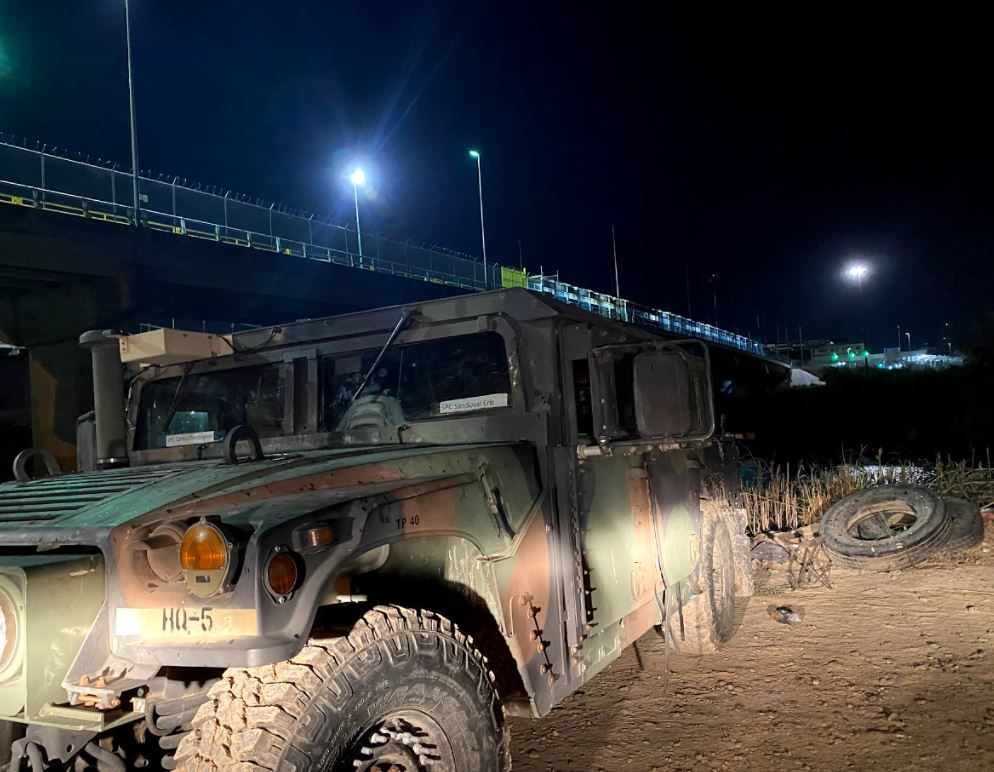
None wanted to chat. But eventually, they offered that their job was to observe and prevent trouble as the smuggling went on in front of them. It also became obvious that they were coordinating with Border Patrol by radio to send the immigrants like the 16-year-old girls up our dirt road to Border Patrol’s processing station in that Roma neighborhood. They had no arrest authority, anyway.
After that first boat load, I asked them: “So what’s going to happen now?”
One of the soldiers answered: “Just what you just saw. I mean, I can’t do anything about it.”
Can’t you guys just tackle the smugglers or something, I ask knowing the answer, and put a stop to this? He answered, maybe Texas DPS officers or Border Patrol were there.
“You would think, right? We’re just here counting – all night.”
I asked, what can’t you do and what can you do with those weapons, for example?
He answered, “Oh, that’s just for our protection, because you never know….”
He mentioned that another raft is on the way. I heard the paddling and headed down to the shore. It was the same pilot; it seemed as though he established himself at this crossing where the river current seemed moderate. Some 15 men, women and very small children were in this boat.
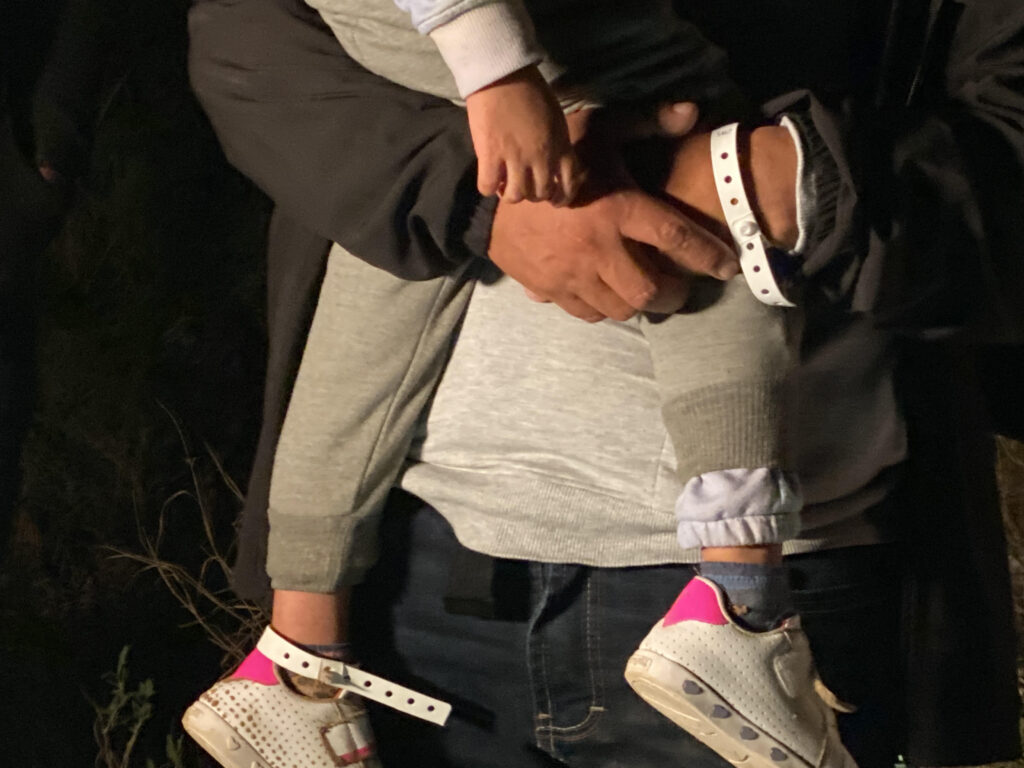
It landed in my flashlight. I stood right next to it when the smuggler pilot ordered everyone out. They are all women and children.
I also felt surprised to see them all wearing covid masks and life vests, since cartel smugglers are not reputed to be very safety conscious.
All also sported numbered wrist bands. The bands are a recent cartel inventory control innovation, seen as necessary with such high volumes coming in, to track that each has paid their $5,000 smuggling ticket before they board. Many tear them off once they reach Texas, so the bands litter the waterfront and the dirt roads leading up to Roma.
When the raft was empty, I asked the smuggler if he spoke English. “No good! No English!” he answered, friendly enough, as he paddled back to his line of waiting immigrants on the Mexico side.
In this mass immigration crisis, the families don’t run and evade. They seek out anyone in a uniform. I followed these immigrants up the sand to the tree line next to the National Guard post. They lined up there in the dark, single file, near the road we’d used to get there. I couldn’t tell how they knew to do that, but guessed the national guardsmen, who were in radio contact with the Border Patrol station up the dirt road in Roma, had instructed them to wait there until there was room up at the processing station.
None the immigrants spoke to one another, used their cell phones or displayed any sort of emotion after just making it into America. All of the immigrants I met showed the same quiet, compliant patience.
Soon, their ranks swelled with other river arrivals, until the group peaked at perhaps 50 assembled people. Then, on a signal from a soldier, they all departed up the dirt road, presumably when Border Patrol signaled for them.
Curious about the flashlights I was seeing a hundred yards down river on our Texas side, I decided to go check it out. Down there in the pitch dark, I was able to see more rubber rafts reaching shore. Men, women and children came up the bank and passed all around me, responding to my greetings but largely uninterested as they headed up a different dirt road. Two of the raft pilots in one of the boats, paddling back using their hands, declined my requests that they stay and chat.
They had business on the other shore, judging again from the flashlights and voices of men, women and children over there.
More lights further downstream lured me, but on the way a cell phone light that suddenly sparked up in a thick clump of brush ahead spooked me, so I turned back. It didn’t matter; clearly the rafting was happening up and down this stretch.
All of the cargo was threading its way up dirt roads toward Roma. I decided to go see the mobile Border Patrol processing station.
The station
At about 2 a.m., after watching dozens of boats deliver their loads, I hiked alone back up the dirt road to find the mythological makeshift Border Patrol processing station. I found it in a vacant lot between ramshackle Roma houses where chained dogs kept up an incessant barking.
I was stunned to see the raft loads accumulated in one spot like this, close to 400 immigrants at that moment. They were sitting or standing, bathed in a flood of light from surrounding Border Patrol vehicles. At least two large white school bus vehicles idled in the vicinity, driver’s waiting behind their wheels.
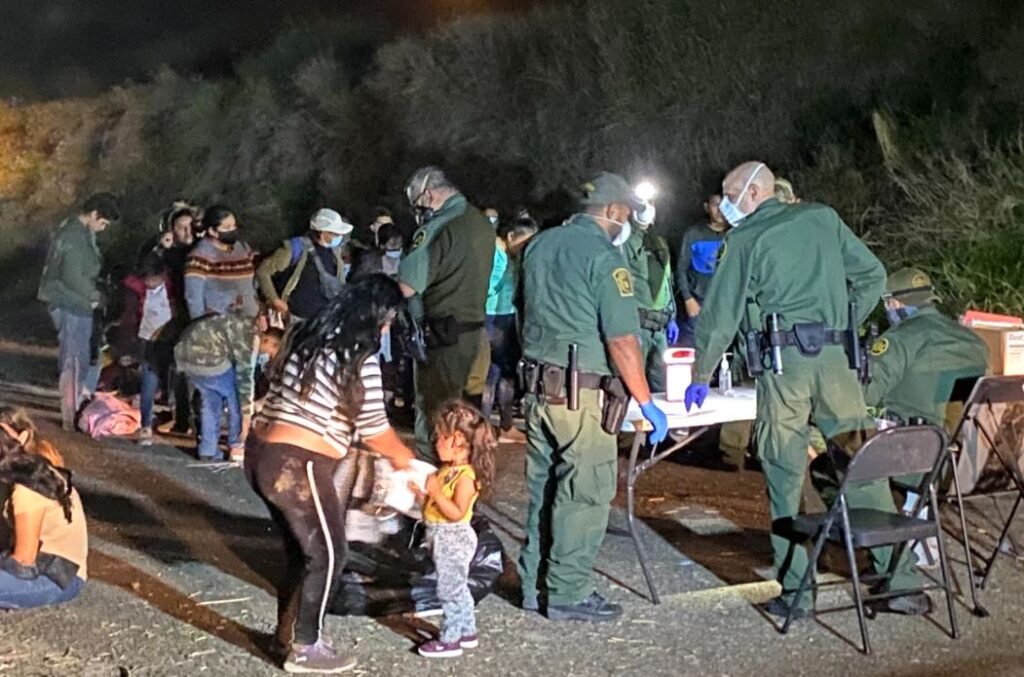
Every few minutes, another large group of immigrants arrived from the river roads and entered the process queue , as the buses slowly filled with those who’d already gone through it. The buses were headed to a brick-and-mortar Border Patrol facility where immigrants could get cleaned up and processed for release into the nation a day or two later.
I counted at least ten agents working at the field station, none of whom would say how many full buses had already departed for the brick-and-mortar facility.
One agent eventually confided that this kind of traffic had been going on for hours already and would go on for at least another three before slowing, the same as it does every single day.
“And this isn’t even one of the hotspots,” the Border Patrol agent added.
Here’s how it all worked:
New arrivals took their seats on the ground while agents tended to water, food, baby formula and diaper needs. Every so often, an agent would call for some to join a standing line to a plastic table and folding chairs manned by five Border Patrol agents.
One agent would collect their personal belongings in a plastic bag with their names on it. These would go separately to the brick-and-mortar facility. Other agents would take their personal information and shoot photos, then put them in another queue for when the time came to load up the buses.
The mobile stations can form up anywhere on a moment’s notice. On another night near Roma, the rafters started showing up on either side of the international bridge. In short order, Border Patrol vehicles pulled up in various kinds of vehicles and went at it for hours as ever more rafts emptied through the night.
As with what I’d seen earlier upriver, the smugglers and badge carriers worked together in their truce, the immigrants compliant and quiet as they turned themselves in and lined up.
This is what normalized industrial-scale illegal migration, the switch stuck on stratospheric, looks and feels like. Acclimate to it, as there seems no end in sight with or without the benefit media enlightenment.